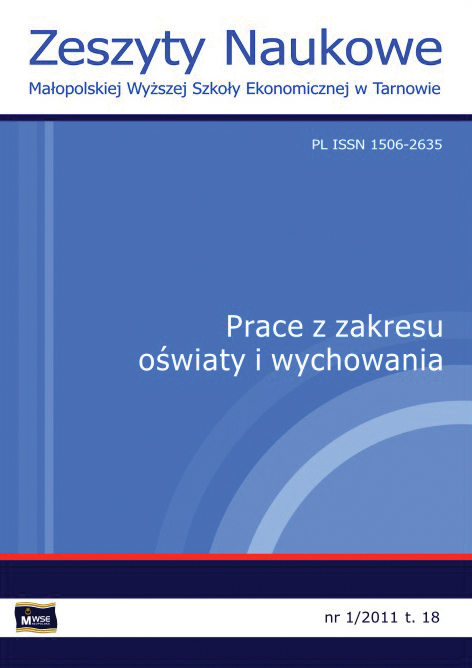Abstract
This study was developed in reference to the ongoing discussions in the academic environment, concerning the unwillingness of students to benefit from academic textbooks. It called for attention to a more detailed issue: to the problems in the use by the students of business studies (including the Faculty of Management) of academic textbooks for mathematics. These problems are largely caused by factors unrelated to the students. The mathematical language is characterised by a specific features: symbols, formal writing, phrases different than in everyday language, the use of drawings (graphs), which should be interpreted. A student who at an earlier stage of training was not prepared to use the mathematical texts, encounters a barrier at this stage of education - perceives this type of texts as a hermetic, hard to understand. In the initial part of the article, based on the literature in the field of didactics of mathematics, what is the specifics of mathematical language, and what features distinguish a mathematical text from other texts has been discussed. The reading of mathematical text requires from the readers special mathematical activity, which was signalled at this point. In the further part of the studies, the results of research concerning the role of textbooks for mathematics in the process of education of economic studies have been presented. Also a classification of textbooks for mathematics for students of economics available for publishing on the market, in terms of their desing concepts have also been presented. The final section contains conclusions, which also formulate a response to earlier questions. The reflections are supplemented by a list of heuristic rules that can help students working with mathematical text.
References
Archibald G.C., Lipsey R.G. 1989. An Introduction to a Mathematical Treatment of Economics. London: Weidenfeld and Nicolson.
View in Google Scholar
Izugala J., Sieczko A., Szal B. 2006. Koncepcje podręczników akademickich do matematyki dla studentów studiów ekonomicznych. [w:] Treliński G. (red. nauk.). Edukacja matematyczna na i studiach ekonomicznych. Kielce: Wyższa Szkoła Ekonomii i Administracji, s. 127-143.
View in Google Scholar
Hoy M. i in. 2001. Mathematics for Economics. London: The MIT Press.
View in Google Scholar
Jacques I. 2003. Mathematics for Economics and Business. Essex: Financial Times Prentice Hall.
View in Google Scholar
Konior J. 2002a. Budowa i lektura tekstu matematycznego. Podstawy nauki czytania tekstów matematycznych w szkole. (Przedruk z: Wydawnictwo Uniwersytetu Śląskiego w Katowicach, Katowice 1998). [w:] J. Żabowski (red.). Materiały do studiowania dydaktyki matematyki. Cz. 4. Prace prof. dr. hab. Jana Koniora. Płock: Szkoła Wyższa im. Pawła Włodkowica, s. 255-286.
View in Google Scholar
Konior J. 2002b. Dlaczego uczyć czytania i redagowania tekstów matematycznych. (Przedruk z: "Nauczyciele i Matematyka", 1998, nr 26). [w:] Żabowski J. (red.). Materiały do studiowania dydaktyki matematyki. Cz. 4. Prace prof. dr. hab. Jana Koniora. Płock: Szkoła Wyższa im. Pawła Włodkowica, s. 287-291.
View in Google Scholar
Konior J. 2002c. Praca ucznia z tekstem matematycznym w świetle realizacji celów zreformowanego nauczania. (Przedruk z: "Matematyka", 2000, nr 6). [w:] Żabowski J. (red.). Materiały do studiowania dydaktyki matematyki. Cz. 4. Prace prof. dr. hab. Jana Koniora. Płock: Szkoła Wyższa im. Pawła Włodkowica, s. 315-325.
View in Google Scholar
Krygowska Z. 1977. Zarys dydaktyki matematyki. Cz. 2. Warszawa: WSiP.
View in Google Scholar
Krygowska Z. 2003. Główne problemy i kierunki badań współczesnej dydaktyki matematyki. (Przedruk z: "Dydaktyka Matematyki", 1981, nr 1 ). [w:] Żabowski J. (red.). Materiały do studiowania dydaktyki matematyki. T. 1. Prace prof, dr Anny Zofii Krygowskiej. Płock: Szkoła Wyższa im. Pawła Włodkowica, s. 127-176.
View in Google Scholar
Nowecki B. 2001. Lektura tekstu matematycznego na przykładzie zadań. (Przedruk z: "Oświata i Wychowanie", wersja B 15, "Dydaktyka Matematyki", 1984 [535]). [w:] Żabowski J. (red.). Materiały do studiowania dydaktyki matematyki. T. 2. Prace prof. dr. hab. Bogdana J. Noweckiego. Płock: Szkoła Wyższa im. Pawła Włodkowica, s. 71-79.
View in Google Scholar
Soper J. 1999. Mathematics for Economics and Business. Oxford: Blackwell.
View in Google Scholar
Steen L.A. 1983. Matematyka dzisiaj. [w:] Steen L.A. (red.). Matematyka współczesna - dwanaście esejów. Warszawa: Wydawnictwo Naukowo-Techniczne.
View in Google Scholar
Tietze J. 2003. Übungsbuch zur angewandten Wirtschaftsmathematik. Wiesbaden: Vieweg Verlag.
View in Google Scholar
Turnau S. 1990. Wykłady o nauczaniu matematyki. Warszawa: PWN
View in Google Scholar
© Copyright by Małopolska School of Economics in Tarnów. The articles are available under the Creative Commons Attribution NonCommercial-NoDerivatives 4.0 International License


